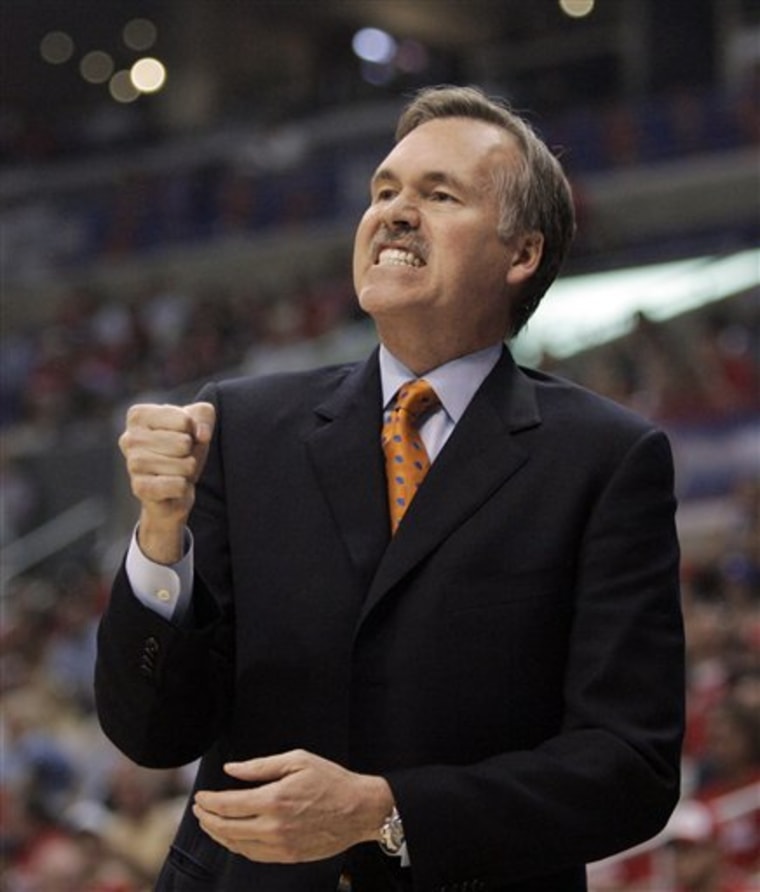When the NBA's renaissance is chronicled, Don Nelson and Mike D'Antoni will go down as the great innovators. When Pat Riley was stuck on analog, they thought digital. When the league became more physical and predictable — when finding an antidote to Shaquille O'Neal was all that mattered — they saw the future in a 6-foot-nothing point guard who skittered around the court like a water bug.
When people think back to when the game became good again, Steve Nash should be remembered as their instrument for change.
Nelson no longer coaches Dallas and D'Antoni has but three years under his belt in Phoenix. But both visionaries were told their crazy offensive ideas about building a championship-caliber team were flawed and unconventional, if not foolish. Sometime in the mid-1990s, the playoffs became more about stopping your opponent than outscoring it. And a team without a bona fide big man was not supposed to last into May.
That thinking made Nelson and D'Antoni outcasts in their own profession, the picked-on brainy kids in gym class. In a copycat league where defense and intimidation were king, they forged ahead anyway, sometimes for the betterment of the game more than their own franchises.
Tonight, in Game 1 of the Western Conference finals, their innovation will be rewarded. Dallas and Phoenix staved off superior big men in Game 7s and now will play for a berth in the NBA Finals. It's just wild to think two "small ball" squads are eight wins from a championship. The larger prize for D'Antoni and Nelson is that they contributed to a climate that made the game worth watching again.
They didn't just bring back scoring in the 120s; they brought back moving the ball like a hot potato. They brought back lean frames, players who need to stay in shape to play the style of the Suns and Mavericks. They also contributed to the death of the center position, or at least the redefinition of a pivot's job.
Boris Diaw, a natural point guard at 6 feet 8, is now the Suns' starting center. He runs, he moves and he spots up consistently from inside 20 feet. Two classic centers, DeSagana Diop and Erick Dampier, share the position for Dallas. But the Mavericks' truly effective big men are the lithe and agile Dirk Nowitzki and Josh Howard.
The game has gone so dizzy with change that Bill Walton almost sold himself out Monday night. One of the great centers said his breed is dying, if not dead. He was at home in San Diego, watching the furious pace of back-to-back Game 7s, and he kept calling a friend back to rave about Nash, whom Walton described as "short, slow and can't jump."
"But he's the most appealing player in the game," Walton said. "The most exciting player in the game. His legacy comes down to showing everyone that this game wasn't about size and strength."
No one would say LeBron James, Carmelo Anthony and Chris Bosh weren't franchise-altering picks. But it's no coincidence the last two guys chosen in the first round of the 2003 draft — Phoenix's Leandro Barbosa and Dallas's Howard — are playing for a trip to the Finals. They represent that combination of skill, speed and constant movement that other teams need and want to emulate.
"Nellie started the league on this trend but Mike D'Antoni has continued the vision," said Jeff Van Gundy, who was once a Riley disciple in New York and now coaches Houston. "I remember every time Mike put a big lineup out there when he first got to the Suns, we killed them."
But when D'Antoni began experimenting with the sinewy Shawn Marion, a natural swingman, at the power forward position and Amare Stoudemire, more of an athletic power forward, at the center position, the Suns changed their game. "Mike had the courage to do it and stick with it," Van Gundy said. "He's never veered from who he is and who his team is."
Said Walton: "Look at Dallas. They're the perfect example of where the NBA is going. They spend all this money on these big stiffs, but Marquis Daniels, Josh Howard and Devin Harris are the reason they're going to the conference finals — these lithe, fast and smart players. It's not because they got these big power guys inside."
All of the NBA's signature eras had been forgotten on the court: Bill Russell and the team game. The Knicks and the brilliance of the smaller, undersize squad winning with passing. Kareem Abdul-Jabbar and the skill, grace and beauty belonging to the tallest player on the floor. Bird and Magic — their passing and passion. And even Michael Jordan, the combination of every great player who came before him. It had all been lost in translation, lost in transition.
Until Nash brought it back. Until Nelson and D'Antoni decided to buck convention.
Riley has seen this coming since his warhorse Miami teams were outrun by more athletic Knicks teams in the playoffs. It says something about his ability to remain contemporary that he has gone back to the two-superstar idea. He knows Shaq and Dwyane Wade give him a better opportunity to return to the halcyon days of Magic and Kareem than slogball.
Coincidentally, the man blamed for popularizing thuggery has to knock out the physical and nasty Pistons to return to the Finals, to prove that style doesn't work anymore. Riley has to kill the part of the league he created, the part already dead out West.
"Steve Nash, Barbosa, Howard, Gilbert Arenas — those type of players are the future of basketball," Walton began, "not some lug who's going to stand around and be a 10-year project before they completely break your heart."
